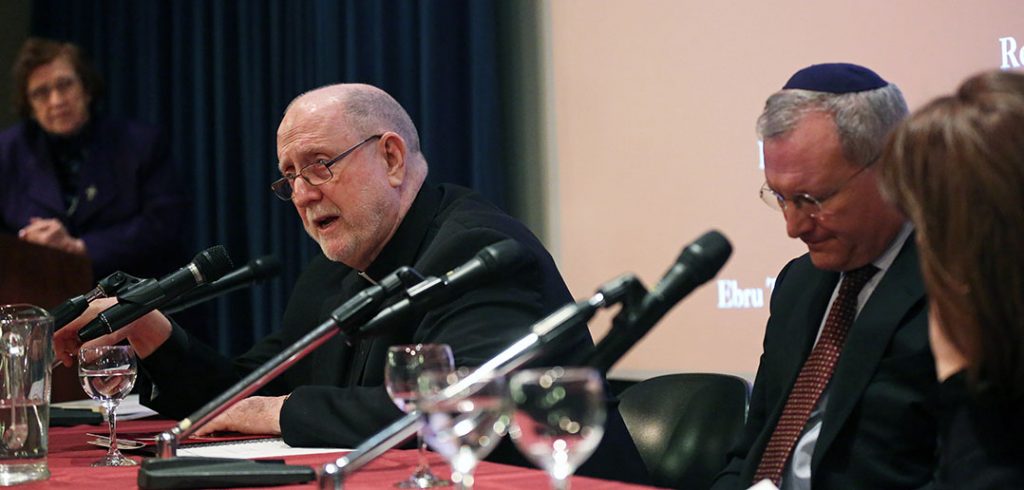In a remarkable departure from the lecture’s usual scholarly tone, Father Ryan included in his presentation a personal narrative that was poignant and relevant to the evening’s topic. He spoke of his father, Paddy Ryan Lacken (1898-1944), who had been arrested and sentenced to death during the civil war that broke out after the failure of the 1921 Anglo-Irish Peace Treaty. Mistakenly sent to a very large prison camp in the Curragh of Kildare, he managed to escape execution by disguising himself and going on the run within the prison camp.
“Oral tradition in the family says that my father, less than 25 years of age at the time, shaved off his hair and grew a mustache, even using actor’s makeup to disguise himself,” said Father Ryan. “I am glad he did escape capital punishment in 1923. I would not be here tonight had he not.”
Father Ryan also culled from his experience as a scholar in North and West Africa for the semi-annual ‘trialogue,’ which presents viewpoints from the world’s three great monotheistic faith traditions on a contemporary topic
Personalizing capital punishment is often an innate part of the debate on the topic, said Pierre M. Gentin, the evening’s respondent from the Jewish perspective and a partner at the law firm of Cahill Gordon & Reindel LLP.
He noted that Jews across the spectrum, from Reform to Conservative to Orthodox, generally find capital punishment anathema because of their shared history of violence, from the crusades to the pogroms to the Holocaust.
“We have an acute awareness of how easily the powerful can put people to death,” he said.
However, Gentin said that it’s easy to ponder the dignity of life and forgiveness in the abstract; it’s another matter when a family member is killed.
“It’s another thing when it’s your child, your parent, or your brother and sister that’s getting stabbed or shot or blown up in a bus,” he said. “The question of capital punishment is not so easily dismissed.”
Gentin said that giving and taking life are “God-like actions” that require serious contemplation.
“It’s absolutely final,” he said of execution. “Human beings have a place in this world that’s a unique place: We are a form of animal that can actually refrain from punishing each other in this final way … I think it has to give one pause as a religious person, but I don’t think it’s a simple question.”
Delivering the response from the Muslim perspective, Ebru Turan, Ph.D., assistant professor of history at Fordham, blamed the reintroduction of capital punishment in Muslim majority nations on the “growing pressure of political Islam.”
“This trend is the fundamental issue that underlies the acts of jihadi violence perpetrated against those who have allegedly insulted or blasphemed Islam in recent years,” she said.
Turan said that Shari‘a-based criminal law replaced European-inspired statutes in the later decades of the 20th century. But Shari‘a laws had rarely been used for capital punishment in the pre-colonial past.
Starting in the 1970s, she said, the pressure of political Islamization brought back harsh disciplines known as “hudud” punishments. She agreed with a statement made by Father Ryan that contemporary advocates of Shari‘a law often disregard the stringent restrictions on capital punishment that were traditionally observed.
“Several verses of the Quran underline the importance of showing clemency and forgiveness for the believers,” she said.
Likewise, Father Ryan said that the “eye for an eye” passage so frequently quoted from the Book of Exodus and used in defense of capital punishment was never meant to have a by-the-book application.
“This law of retaliation was not interpreted literally in ancient Israel, but was understood metaphorically, designating monetary compensation to be paid to a victim by a perpetrator,” he said.
Turan said that the Quran also “strongly urges” that family members of murder victims accept “blood money and not demand the execution of the killer.” And while the Torah also indicates that a Jewish court can impose the death penalty, the Talmud elaborates that the court, known as a Sanhedrin, must be composed of 23 judges.
“In a seemingly counterintuitive ruling—and yet one emblematic of Judaism’s concerns about the death penalty—if all of the Sanhedrin’s judges were unanimous in imposing a death sentence, the accused was set free on the theory that if not a single judge could side with the accused, there was something wrong with that court,” he said.
Father Ryan argued that for Christians, there is no room for strict retaliation in light of Jesus’ Sermon on the Mount, in which he said, “You have heard that it was said, ‘An eye for an eye and a tooth for a tooth.’ But I say to you, Do not resist an evildoer. But if anyone strikes you on the right cheek, turn the other also.”
If any doubt existed that Catholics could still support capital punishment, Father Ryan said that Pope Francis’ recent revision of the Catechism of the Catholic Church declares it inadmissible in all circumstances.
“It is better by far to judge not lest you be judged, as Jesus warns us, and especially when judgment leads to capital punishment,” said Father Ryan. “Reversing capital punishment at a later time is never possible. To use some West African pidgin English—the most expressive language I know—it is better to ‘Lef’ am for God.’ Leave it up to God.”


